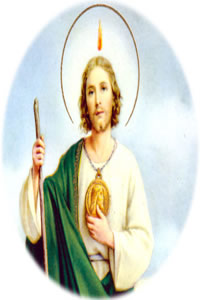St. Jude Thaddaeus

Patron of: Desperate situations, Hope, Hospitals, Lost causes
Celebrated: 28. October
Birth:
Death:
Full biography:
The legend reports that St. Jude was born into a Jewish family in Paneas, a town in Galilee later rebuilt by the Romans and renamed Caesarea Philippi. He probably spoke both Greek and Aramaic, like most of his contemporaries in that area, and was a farmer by trade. According to the legend, St. Jude was a son of Clopas and his wife Mary, a sister of the Virgin Mary. Tradition has it that Jude's father, Clopas, was murdered because of his forthright and outspoken devotion to the risen Christ. Although Saint Gregory the Illuminator is credited as the "Apostle to the Armenians", when he baptized King Tiridates III of Armenia in 301, converting the Armenians, the Apostles Jude and Bartholomew are traditionally believed to have been the first to bring Christianity to Armenia, and are therefore venerated as the patron saints of the Armenian Apostolic Church. Saint Jude suffered martyrdom about 65 AD in Beirut, in the Roman province of Syria, together with the apostle Simon the Zealot, with whom he is usually connected. Their acts and martyrdom were recorded in Acts of Simon and Jude that was among the collection of passions and legends traditionally associated with the legendary Abdias, bishop of Babylon. Sometime after his death, Saint Jude's body was brought from Beirut to Rome and placed in a crypt in St. Peter's Basilica. According to popular tradition, the remains of St. Jude were preserved in an Armenian monastery on an island in the northern part of Issyk-Kul Lake in Kyrgyzstan at least until the mid-15th century. Jude is traditionally depicted carrying the image of Jesus in his hand or close to his chest, betokening the legend of the Image of Edessa, recorded in apocryphal correspondence between Jesus and Abgar which is reproduced in Eusebius' History Ecclesiastica, I, xiii. Eusebius relates that King Abgar of Edessa (now in southeast Turkey) sent a letter to Jesus seeking a cure for an illness afflicting him. With the letter he sent his envoy Hannan, the keeper of the archives, offering his own home city to Jesus as a safe dwelling place. The envoy painted a likeness of Jesus with choice paints (or alternatively, impressed with Abgar's faith, Jesus pressed his face into a cloth and gave it to Hannan) to take to Abgar with his answer. Upon seeing Jesus' image, the king placed it with great honor in one of his palatial houses. After Christ's execution, Thomas the Apostle sent Jude to King Abgar and the king was cured. Astonished, he converted to Christianity, along with many of the people under his rule. Additionally, St. Jude is often depicted with a flame above his head, representing his presence at Pentecost, when he was said to have received the Holy Spirit with the other apostles.
Prayer:
Most holy Apostle Saint Jude, faithful servant and friend of Jesus, the name of the traitor who delivered the beloved Master into the hands of His enemies has caused you to be forgotten by many, but the Church honors and invokes you universally as the patron of hopeless cases, of things almost despaired of. Pray for me, I am so helpless and alone. Make use I implore you, of that particular privilege given to you, to bring visible and speedy help, where help is almost despaired of. Come to my assistance in this great need, that I may receive the consolations and help of Heaven in all my necessities, tribulations and sufferings, particularly your request and that I may bless God with you and all the elect forever. I promise, O blessed Saint Jude, to be ever mindful of this great favor, to always honor you as my special and powerful patron, and to gratefully encourage devotion to you. Amen
